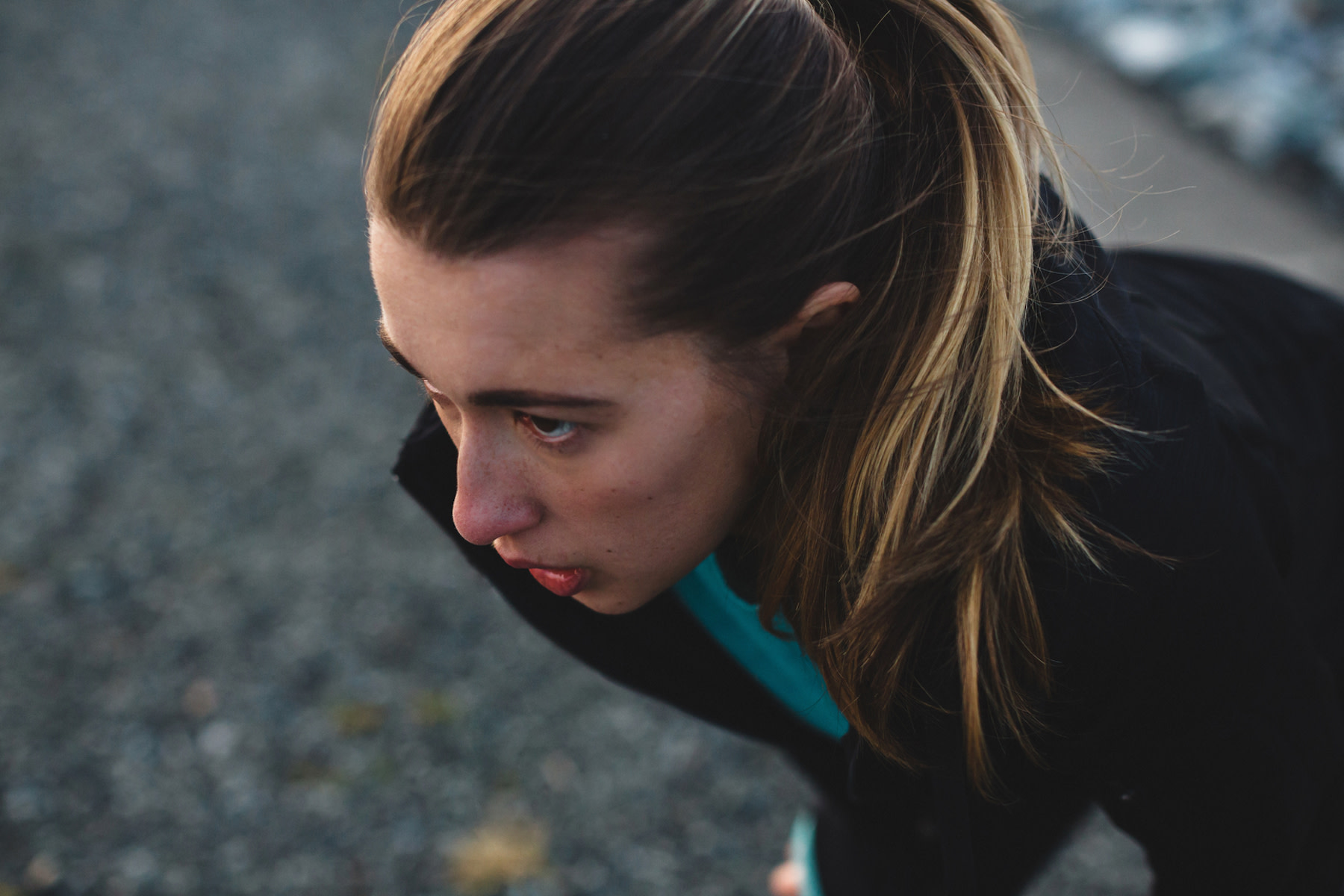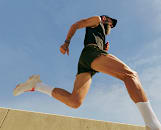
© Rob and Julia Campbell / Stocksy United
7 Reasons Why You May Feel Nauseous After a Workout—and How to Prevent It
Post-exercise queasiness can be fairly common, but there are a few ways you can prevent it from happening in the first place.
By Blake Bakkila•
Why Do I Feel Sick or Nauseous After a Workout?
Is Nausea After Exercise Normal?
How to Stop Feeling Nauseous After Working Out
How to Prevent Nausea After Exercise
The Takeaway
Exercising can make you feel happy, sweaty, and accomplished—but can it also make you feel queasy? Short answer: yes.
Discover more ways to reach your goals with Peloton
Feeling sick or nauseous after a workout is something that can happen to fitness enthusiasts and beginners alike. The good news: There are certain measures you can take to relieve and prevent this symptom, no matter your fitness level.
To help you bid farewell to nausea after workouts in the future, we spoke with two experts: Shoshana Ungerleider, MD, a board-certified internal medicine physician at Crossover Health, and Natalie Rizzo, RD, a registered dietitian, author of Planted Performance, and founder of Greenletes. They break down how everything from nutrition and hydration to your environment can affect your performance. Spoiler alert: Just a few simple adjustments to your pre- or post-workout routines can drastically change how you feel after exercising and, hopefully, reduce some of that queasiness.
Why Do I Feel Sick or Nauseous After a Workout?
There are several reasons why you may experience nausea after working out. Your pre-workout meal, exercise conditions, and other unique health factors can all make you feel less than great after you’re done moving. It’s likely that when, what, and how you eat and drink beforehand is the main culprit to nausea after exercise.
Here are some of the most common causes behind nausea after a workout, according to Dr. Ungerleider and Rizzo.
1. Dehydration
Both Dr. Ungerleider and Rizzo agree that dehydration is one of the primary reasons for feeling nauseous after a workout. “Dehydration can cause nausea, fatigue, and headaches,” Rizzo says, adding that urinating less often or having dark-yellow urine can signal you’re experiencing this issue.
2. Lowered Blood Sugar
The last thing you want to do is perform a high-intensity workout on an empty stomach or without enough carbohydrates to fuel you. Without enough gas in your tank (er, food in your body) before a workout, you might wind up with some queasiness.
3. Eating Too Soon Before a Workout
While working out on an empty stomach can lead to nausea, the timing of your meal also matters. “Choosing the right types of macros and timing them properly for your workout is the difference between being properly fueled and feeling awful,” Rizzo says. “If you eat a food with fat and/or protein too close to the workout, it may not get digested quickly and can sit in the stomach and cause nausea.”
4. Blood Redistribution
“During intense exercise, blood is redirected from the stomach and intestines to the muscles and skin to support the increased demand for oxygen and to help dissipate heat,” Dr. Ungerleider says. “This reduced blood flow to the gut can impair digestion, leading to nausea.”
5. Lactic Acid Buildup
This is particularly common for those participating in high-intensity interval training (HIIT) sessions or sprints. It happens when the body produces lactic acid faster than it can be cleared, Dr. Ungerleider says.
6. Doing Workouts That Jostle Your Belly Around
For example, Rizzo says that the “up and down motion of the stomach” during a run can also cause nausea after a workout, as can pushing past your limits and overdoing it during a training session.
7. Heat-Related Stress
Are you working out in a heated workout studio or outdoor environment with high temperatures? If so, you’re more at risk of experiencing heat exhaustion or heat stroke, both of which can cause nausea.
Related Articles

Mental Health
What Does It Mean to ‘Listen to Your Body’ During a Workout?

Health
7 Reasons Why You May Feel Lightheaded After a Workout, According to Experts

Health
How to Prevent Runner’s Stomach from Ruining Your Next Long Run or Race

Nutrition
Should You Eat Before or After a Workout? Ask Yourself These 4 Questions to Decide
Is Nausea After Exercise Normal?
Feeling nauseous after a workout is a fairly common complaint among athletes and fitness enthusiasts, Dr. Ungerleider says. Nausea after exercise is especially normal for those participating in high-intensity workouts like running, Rizzo adds.
In fact, a 2017 study found that up to 90 percent of runners may experience gastrointestinal (GI) symptoms during endurance races, including (yep, you guessed it) nausea. Other common upper-GI symptoms athletes experienced during the study include reflux (feeling like your food is coming back up) and stomach fullness, while lower-GI symptoms include abdominal cramps, gas, and the urge to defecate.
Furthermore, a 2013 review estimated that anywhere from 20–70 percent of athletes have dealt with GI symptoms like nausea. There are also near-countless online forums with people asking why they feel sick after working out. And while things like nausea might be considered pretty common after exercising, it’s also avoidable with the proper modifications.
How to Stop Feeling Nauseous After Working Out
So, you just wrapped up a workout and a bout of nausea has struck. How exactly can you help stop this feeling? Here are some helpful strategies, which you can try out after evaluating potential causes for your GI symptoms:
Cool down and rest up: Find a cool, shaded spot where you can relax after your workout, Dr. Ungerleider recommends. “Placing a cold cloth on the forehead or back of the neck can be beneficial,” she adds.
Hydrate and refuel responsibly: Because dehydration is a common cause of nausea after a workout, make sure to take in the necessary amount of fluids after exercising. “Hydrate with electrolytes and eat small amounts of food until you’re able to eat a larger meal,” Rizzo says. “Opt for some carbs and protein together, such as a fruit smoothie with a little bit of yogurt (if you can handle it).” Dr. Ungerleider also recommends taking small sips of water or an electrolyte solution and avoiding chugging.
Control your breathing: Take deep and controlled breaths to try to alleviate your nausea, Dr. Ungerleider advises. Letting your heart rate come down is another step you can take to feel better, according to Rizzo.
Keep these practical tools in mind the next time you're feeling nauseous or sick after working out.
How to Prevent Nausea After Exercise
After feeling the urge to toss your cookies, you might feel like avoiding your favorite workouts for a while. But in most cases, you don’t need to skip this typically stress-relieving, joy-inducing part of your routine just because of your GI symptoms. Moving forward, you can instead prepare more efficiently and take the necessary steps to safely exercise without welcoming any of that dreaded post-workout nausea.
Here are some pro tips for preventing nausea after exercise in the future:
Carefully consider your pre-workout fuel: “If you eat within 60 minutes before a workout, opt for a simple carb, such as a banana or some crackers or a small piece of toast,” Rizzo recommends. “These things are easy to digest and quickly give you energy. They won’t sit in the stomach and cause GI issues.” Dr. Ungerleider also recommends what not to eat as a pre-workout snack: Avoid anything that’s heavy, fatty, or spicy right before you exercise to help fend off nausea.
Pace yourself: If you’re overdoing it during a workout, nausea can come into play—which is why it’s so important to be mindful of your output. “Gradually increase the intensity and duration of your workouts, allowing your body to adapt to physical stress over time,” Dr. Ungerleider says.
Focus on breathing correctly: Make sure you’re breathing properly while exercising, which Dr. Ungerleider says “helps with oxygen delivery and lactic acid clearance.” How to best breathe during a workout depends on the type of exercise you’re doing. For instance, taking deep, slow breaths is best for yoga, while breathing in through your nose and out through your mouth is the preferred technique for cardio. Knowing the best breathing techniques for the workout you have planned can help set yourself up for success—and hopefully ward off some of that post-exercise queasiness.
Factor in your environment: Are you exercising in an area with high temperatures? If so, you'll want to make sure you’re acclimated to the temperature. That way, you can better avoid nausea-inducing heat exhaustion or heat stroke.
Listen to your body: “Always pay attention to how your body reacts to different exercises, intensities, or routines,” Dr. Ungerleider says. “If a particular activity consistently makes you nauseous, consider modifying it or consulting with a fitness professional.”
Before and during your next workout, this expert-led guidance can help you avoid feeling sick after exercising. And while it’s normal to experience bouts of nausea from time to time, you should speak with a healthcare provider if you’re dealing with this symptom (or other concerning symptoms) frequently after getting active.
Seek out emergency medical assistance if your nausea and vomiting are accompanied by the following symptoms, per the Mayo Clinic: chest pain, severe abdominal pain or cramping, blurred vision, confusion, high fever and stiff neck, fecal material or fecal odor in your vomit, and/or rectal bleeding.
The Takeaway
Nausea after a workout is fairly common and is typically caused by dehydration, nutrition, and your environment. Post-exercise GI challenges like nausea can usually be resolved with a slight adjustment to your eating and drinking schedule. However, nausea could also serve as a warning sign of something more serious happening during and after your workout. Exercising should only make you feel better, and maybe a bit sore or tired. If you make the changes recommended by Dr. Ungerleider and Rizzo above (such as pacing yourself, focusing on your breath, and listening to your body) and still experience nausea after a workout, don’t hesitate to contact a healthcare provider for help.

Peloton App
Access thousands of classes with no equipment needed.
This content is for informational and educational purposes only and does not constitute individualized advice. It is not intended to replace professional medical evaluation, diagnosis, or treatment. Seek the advice of your physician for questions you may have regarding your health or a medical condition. If you are having a medical emergency, call your physician or 911 immediately.
Level up your inbox.
Subscribe for a weekly dose of fitness, plus the latest promos, launches, and events.
By providing your email address, you agree to receive marketing communications from Peloton.
For more about how we use your information, see our Privacy Policy.




